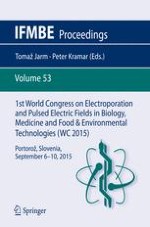2016 | OriginalPaper | Buchkapitel
Microbial Inactivation in a Non-commercial Juice of Mango and Papaya Submitted to Pulsed Electric Fields in Presence of a Stevia rebaudiana Bertoni Extract
verfasst von : C. M. Belda-Galbis, A. Martínez, D. Rodrigo
Erschienen in: 1st World Congress on Electroporation and Pulsed Electric Fields in Biology, Medicine and Food & Environmental Technologies
Verlag: Springer Singapore
Aktivieren Sie unsere intelligente Suche, um passende Fachinhalte oder Patente zu finden.
Wählen Sie Textabschnitte aus um mit Künstlicher Intelligenz passenden Patente zu finden. powered by
Markieren Sie Textabschnitte, um KI-gestützt weitere passende Inhalte zu finden. powered by
Unpasteurized fruit juices are perishable products whose microbiological spoilage supposes great economic losses for the food industry. Besides, they can support the survival and growth of human pathogens. Actually, different juices have been involved in major foodborne illnesses outbreaks. Therefore, they should be submitted to treatments that prevent their microbiological spoilage and ensure their microbiological safety. In response to consumer demand for minimally processed foods, without synthetic additives, significant efforts are leading to the development of novel non-thermal technologies, such as the application pulsed electric fields (PEF), to extend juices’ shelf life avoiding thermal processing. The combination of those technologies with preservatives from vegetal, animal and microbial origin could be a convenient strategy to obtain high-quality foods, from farm to fork. Considering
Stevia rebaudiana
Bertoni (
Stevia
)antibacterial and antifungal properties, PEF antimicrobial potential in a juice containing
Stevia
was assessed. With this aim, the effect of PEF and
Stevia
on the microbial load of non-sterile and sterile samples inoculated with
Listeria monocytogenes
was determined. In view of the results obtained, PEF processing reduced the microbial load of the juice under study. Based on cell counts performed before and after different PEF treatments, in presence of different concentrations of
Stevia
, it was observed that the higher the electric field and the treatment time, the higher the inactivation.
Stevia
addition reduced PEF effectiveness against yeast, molds and mesophiles, but increased its effectiveness against
L. monocytogenes
. Anyway, the joint application of PEF and
Stevia
not fulfilled with the microbiological criteria required for this kind of products. Further studies are needed to evaluate
Stevia
effects during post-processing storage. In addition, the study of other strategies should not be neglected for juices’ preservation exploiting the antimicrobial potential of PEF.
